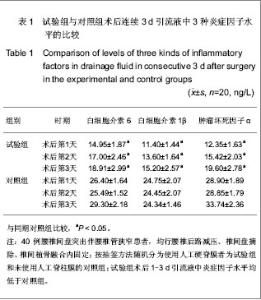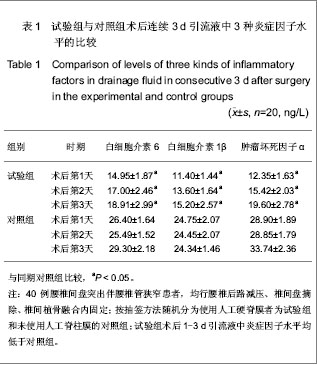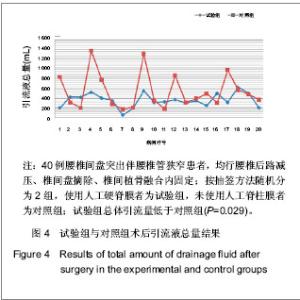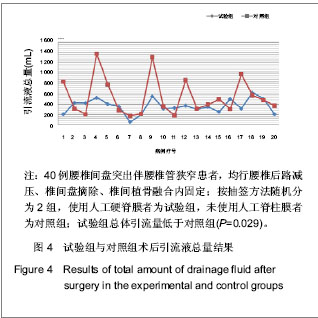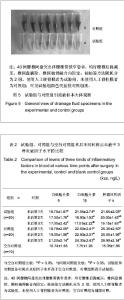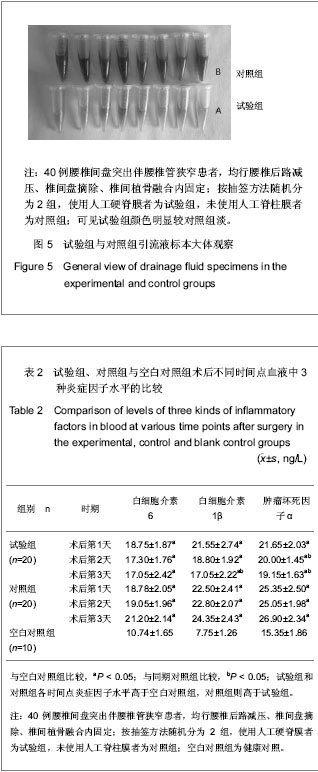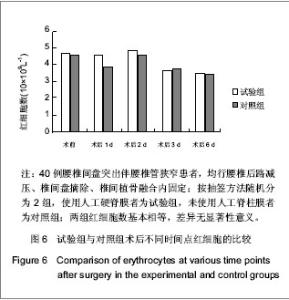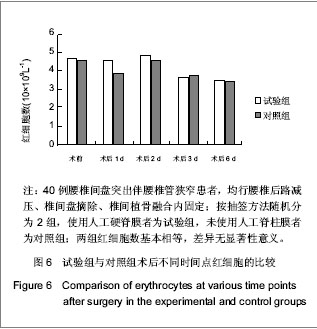| [1] Fayad F,Lefevre-Colau MM,Rannou F,et al.Relation of inflammatory modic changes to intradiscal steroid injection outcome in chronic low back pain. Eur Spine J.2007;16(7): 925-931.[2] Peng B,Zhang Y,Hou S,et al. Intradiscal methylene blue injection for the treatment of chronic discogenic low back pain. Eur Spine J.2007;16(1):33-38.[3] McAuley D,Russell C,Farling P.Adcon-L gel andintraoperative hypotension during lumbar discectomy.Br J Neurosurg.2004; 18(2):180-182.[4] Ivanic GM,Pink TP,Homann NC,et al.The post-discectomy syndrome—aetiology, diagnosis,treatment, prevention. Arch Orthop Trauma Surg.2001;121(9):494-500.[5] Ivanic GM,Pink PT,Schneider F,et al.Prevention of epidural scarring after microdiscectomy:a randomized clinical trial comparing gel and expanded polytetrafluoroethylene membrane. Eur Spine J. 2006;15(9):1360-1366.[6] Lladó A,Sologaistua E,Guimerá J,et al.Expanded polytetrafluoroethylene membrane for the prevention of peridual fibrosis after spinal surgery:a clinical study.Eur Spine J.1999;8(2):144-150.[7] Ozaktay AC,Kallakuri S,Takebayashi T,et al. Effects of interleukin -1 beta,interleukin -6,and tumor necrosis factor on sensitivity of dorsal root ganglion and peripheral receptive fields in rats. Eur Spine J .2006; 15(10):1529-1537.[8] Nagashima H,Morio Y,Yamane K,et al.Tumor necrosis factor-alpha, interleukin-1beta, and interleukin-6 in the cerebrospinal fluid of patients with cervical myelopathy and lumbar radiculopathy.Eur Spine J.2009;18(12):1946-1950.[9] Ozaktay AC,Kallakuri S,Takebayashi T, et al. Effects of interleukin -1 beta,interleukin -6,and tumor necrosis factor on sensitivity of dorsal root ganglion and peripheral receptive fields in rats. Eur Spine J.2006;15(10):1529-1537.[10] Miyagi M,Ishikawa T,Orita S,et al. Disk injury in rats produces persistent increases in pain-related neuropeptides in dorsal root ganglia and spinal cord glia but only transient increases in inflammatory mediators: pathomechanism of chronic diskogenic low back pain. Spine (Phila Pa 1976). 2011;36(26): 2260-2266.[11] Du XR,Ye QB,Zhao LX,et al.Zhongguo Linchuang Jiepouxue Zazhi. 2002;20(2):86-89.杜心如,叶启彬,赵玲秀,等.腰椎人字嵴顶点椎弓根螺钉进钉方法的解剖学研究[J].中国临床解剖学杂志,2002,20(2):86-89.[12] Igarashi A, Kikuchi S, Konno S. Correlation between inflammatory cytokines released from the lumbar facet joint tissue and symptoms in degenerative lumbar spinal disorders.J Orthop Sci. 2007;12(2):154-160.[13] Takahashi H,Suguro T,Okazima Y,et al. Inflammatory cytokines in the herniated disc of the lumbar spine. Spine (Phila Pa 1976).1996;21(2):218-224.[14] Genevay S,Finckh A,Payer M,et al.Elevated levels of rumor necrosis factoralpha in periradicular fat tissue in patients with radiculopathy from herniated disc. Spine (Phila Pa 1976). 2008; 33(19):2041-2046.[15] Seguin CA,Pilliar RM,Roughley PJ,et al.Toumor neurosis factor-alpha modulates matrix production and catabolism in nucleus tissue. Spine (Phila Pa 1976).2005;30(17); 1940-1948.[16] Thomas B,Thirion S,Humbert L,et al. Differentiation regulates IL- 1β induced cyclo-oxygenase-2 in human articular chondrocytes:Role of p38 mitogen-activated protein kinase. Biochem J.2002;362 (Part 2):367- 373.[17] Zheng YH,Cao P,Zhang XK,et al.Guoji Gukexue Zazhi. 2011; 32(4):253-256.郑月焕,曹鹏,张兴凯,等.腰椎终板退行性改变与髓核内炎症因子及下腰痛相关性研究[J].国际骨科学杂志,2011,32(4):253-256.[18] Le Maitre CL, Hoyland JA, Freemont AJ. Catabolic cytokine expression in degenerate and herniated human intervertebral discs:IL-βand TNF -αexpression profile. Arthritis Res Ther. 2007;9(4):77-82.[19] Jimbo K,Park JS,Yokosuka K,et al.Positive feedback loop of interleukin-1 beta upregulating production of inflammatory mediators in human intervertebral disc cells in vitro.J Neurosurg Spine.2005;2(5):589-595.[20] Urban JP,Smith S,Fairbank JC. Nutrition of the intervertebral disc. Spine (Phila Pa 1976).2004;29(23):2700-2709.[21] Kato T,Haro H,Komori H,et al. Sequential dynamics of inflammatory cytokine,angiogenesis inducing factor and matrix degrading enzymes during spontaneous desorption of the herniated disc.J Orthop Res.2004; 22(4):895-900.[22] Koga S,Morris S,Ogawa S,et al.TNF modulat esendothelial properties by decreasing cAMP. Am J Ph ysical.1995; 268 (5Pt1): C1104-1113.[23] Ohba T,Haro H,Ando T,et al.TNF-alpha induced NF-kappaB signaling reverses age-related declines in VEGF induction and angiogenic activity in intervertebral disc tissues.J Orthop Res.2009;27(2):229-235.[24] Weiler C,Nedich AG,Bachmeier BE,et al.Expression and distribution of tumor necrosis factor alpha in human lumbar intervertebral discs:a study in surgical specimen and autopsy controls. Spine (Phila Pa 1976).2005;30(1):44-54.[25] Han JJ,Li JM,Ding WY,et al.Zhongguo Zuzhi Gongcheng Yanjiu yu Linchuang Kangfu. 2008;12(33):6462-6465.韩建军,李菊梅,丁文元,等.腰椎间盘突出程度与间盘组织肿瘤坏死因子α水平的关系[J].中国组织工程研究与临床康复,2008, 12(33):6462-6465.[26] Huang SL,Wu TQ,Zhong M,et al.Chengdu Yixueyuan Xuebao. 2009;4(4):274-276.黄泗霖,吴天清,钟 敏,等.腰椎间盘突出症腰腿痛程度与外周血TNF-α水平关系的临床研究[J].成都医学院学报,2009,4(4): 274-276.[27] Ozaktay AC,Cavanaugh JM,Asik I,et al. Dorsal root sensitivity to interleukin-1 beta, interleukin-6 and tumor necrosis factor in rats. Eur Spine J.2002;11(5):467-475. |
